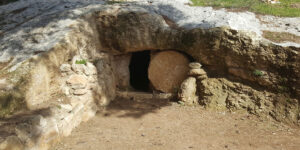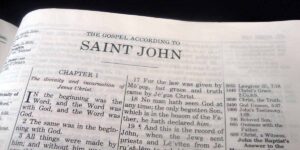Thomas Didymus lived in Galilee. Tradition says he labored in Parthia, Persia, and India, suffering martyrdom near Madras, at Mt. St. Thomas, India.
Thomas was his Hebrew name and Didymus was his Greek name. At times he was called Judas. Matthew, Mark, and Luke tell us nothing about Thomas except his name. However, John defines him more clearly in his Gospel. Thomas appeared in the raising of Lazarus (John 11:2-16), in the Upper Room (John 14:1-6) where he wanted to know how to know the way where Jesus was going. In John 20:25, we see him saying unless he sees the nail prints in Jesus’ hand and the gash of the spear in His side he will not believe. That’s why Thomas became known as Doubting Thomas.
By nature, Thomas was a pessimist. He was a bewildered man. Yet, he was a man of courage. He was a man who could not believe until he had seen. He was a man of devotion and of faith. When Jesus rose, he came back and invited Thomas to put his finger in the nail prints in his hands and in his side. Here, we see Thomas making the greatest confession of faith, “My Lord and my God.” Thomas’ doubts were transformed into faith. By this very fact, Thomas’ faith became great, intense and convincing. It is said that he was commissioned to build a palace for the king of India, and he was killed with a spear as a martyr for his Lord. His symbol is a group of spears, stones, and arrows.
Thomas, so often remembered as “Doubting Thomas,” deserves to be respected for his faith. He was a doubter, but his doubts had a purpose – he wanted to know the truth. Thomas did not idolize his doubts; he gladly believed when given reasons to do so. He expressed his doubts fully and had them answered completely. Doubting was only his way of responding, not his way of life.
Although our glimpses of Thomas are brief, his character comes through with consistency. He struggled to be faithful to what he knew, despite what he felt. At one point, when it was plain to everyone that Jesus’ life was in danger, only Thomas put into words what most were feeling, “Let us also go, that we may die with him” (John 11:16). He didn’t hesitate to follow Jesus.
We don’t know why Thomas was absent the first time Jesus appeared to the disciples after the resurrection, but he was reluctant to believe their witness to Christ’s resurrection. Not even ten friends could change his mind.
We can doubt without having to live a doubting way of life. Doubt encourages rethinking. Its purpose is more to sharpen the mind than to change it. Doubt can be used to pose the question. get an answer, and push for a decision. But doubt was never meant to be a permanent condition. Doubt is one foot, lifted, poised to step forward or backward. There is no motion until the foot comes down.
When you experience doubt, take encouragement from Thomas. He didn’t stay in his doubt but allowed Jesus to bring him to believe. Take encouragement also from the fact that countless other followers of Christ have struggled with doubts. The answers God gave them may help you too. Don’t settle into doubts, but move on from them to decision and belief. Find another believer with whom you can share your doubts. Silent doubts rarely find answers.
Strengths and Accomplishments
- One of Jesus’ 12 disciples
- Intense both in doubt and belief
- Was a loyal and honest man
Weaknesses and Mistakes
- Along with the others, abandoned Jesus at his arrest
- Refused to believe the others’ claim to have seen Christ and demanded proof
- Struggled with a pessimistic outlook
Lessons From His Life
- Jesus does not reject doubts that are honest and directed toward belief
- Better to doubt out loud than to disbelieve in silence
Vital Statistics Thomas Didymus
- Where: Galilee, Judea, Samaria
- Occupation: Disciple of Jesus
- Contemporaries: Jesus, other disciples, Herod, Pilate
Key Verse for Thomas Didymus
“Then he said to Thomas, ‘Put your finger here; see my hands. Reach out your hand and put it into my side. Stop doubting and believe.’ Thomas said to him, ‘My Lord and my God!’ “ (John 20:27-28)
Thomas’s story is told in the Gospels. He is also mentioned in Acts 1:13
Click here to print or download the Bible character study “Thomas Didymus – Doubting Thomas”








